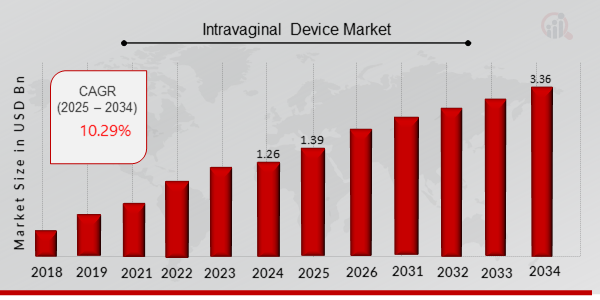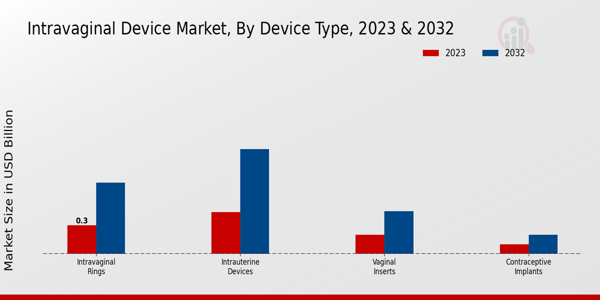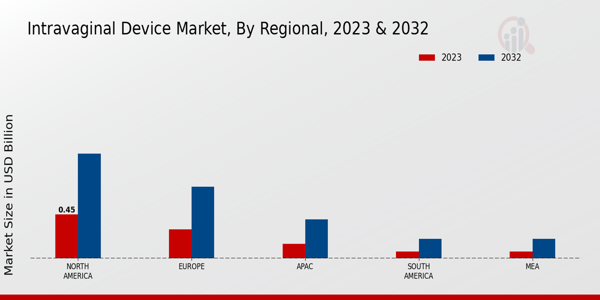Intravaginal Device Market Overview
As per MRFR analysis, the Intravaginal Device Market Size was estimated at 1.26 (USD Billion) in 2024. The Intravaginal Device Market Industry is expected to grow from 1.39 (USD Billion) in 2025 to 3.36 (USD Billion) till 2034, at a CAGR (growth rate) is expected to be around 10.29% during the forecast period (2025 - 2034).
Key Intravaginal Device Market Trends Highlighted
The Intravaginal Device Market is witnessing notable changes driven by several key market drivers. Growing awareness of women's health issues and the rising prevalence of conditions that require intravaginal treatment are pushing demand for these devices. Additionally, advancements in technology enhancing the effectiveness and comfort of intravaginal devices are attracting both healthcare providers and consumers.
Increased investment in research and development plays a crucial role in tailoring these products to meet specific health needs, further fueling market growth. Providers focusing on patient-centered solutions are likely to gain a competitive edge in this evolving landscape.Moreover, there are significant opportunities to be explored within the Intravaginal Device Market. As more women become aware of the options available for various health issues, the demand for innovative products is poised to rise. Companies that invest in developing personalized and multifunctional devices may capture a larger market share.
The trend toward natural and minimally invasive treatment methods can encourage the development of devices that integrate bio-friendly materials, which can appeal to a growing segment of environmentally conscious consumers. Collaborations with healthcare professionals to understand patient needs better could also lead to enhanced product offerings and improved patient satisfaction.Recent trends indicate a shift towards integrating digital technology with intravaginal devices, making them more user-friendly and effective. Telehealth solutions providing consultations for managing intravaginal health issues are gaining traction as they enhance accessibility for patients.
Furthermore, the increasing focus on preventive healthcare and wellness is pushing manufacturers to innovate, ensuring that their products remain relevant and stay ahead of consumer demands.
The market is also seeing a rise in educational campaigns aimed at destigmatizing intravaginal health, which may lead to increased acceptance and usage of these devices among women.Overall, these elements together create a dynamic environment for growth within the Intravaginal Device Market.

Source: Primary Research, Secondary Research, Market Research Future Database and Analyst Review
Intravaginal Device Market Drivers
Growing Awareness and Acceptance of Intravaginal Devices
The Intravaginal Device Market Industry is witnessing a significant increase in awareness and acceptance of intravaginal devices among women worldwide. Educational initiatives and campaigns focusing on reproductive health have contributed to a growing understanding of the benefits and functionality of these devices. As women become more informed about their reproductive health options, they are more likely to turn to intravaginal devices as effective solutions for contraception, hormone delivery, and management of various gynecological conditions.
The rise in acceptance is also driven by the increasing emphasis on women's rights to make informed choices regarding their bodies and health care. The shift towards proactive health measures, combined with the societal changes encouraging open discussions about sexual health, has created a more conducive environment for the adoption of intravaginal devices.
Furthermore, as manufacturers and healthcare providers continue to innovate and improve upon intravaginal devices to enhance usability, comfort, and efficacy, consumer confidence is expected to soar.This growing acceptance not only boosts the market for the devices but also leads to potential advancements in product offerings, thereby influencing the future growth trajectory of the Intravaginal Device Market Industry.
Technological Advancements in Device Design and Functionality
Technological advancements play a crucial role in driving the growth of the Intravaginal Device Market Industry. Innovations in materials and device design have significantly improved user experiences and effectiveness. Newer devices are being engineered for better comfort, ease of use, and more efficacious drug delivery mechanisms. Features such as sustained-release formulations and biodegradable materials enhance the safety profiles of devices while promoting patient adherence.As these technologies evolve, they not only address the traditional barriers associated with existing intravaginal products but also expand the range of treatment options available to women.
Continuous improvements in manufacturing technologies and product development are expected to drive market growth further.
Increased Focus on Reproductive Health and Family Planning
The Intravaginal Device Market Industry is also being propelled by an increase in focus on reproductive health and family planning across various demographics. As more governments, organizations, and healthcare providers advocate for accessible reproductive health services, the demand for effective family planning methods continues to rise. This trend is particularly prevalent in developing regions where education and access to reproductive health resources are being improved.The growing recognition of the importance of family planning in enhancing women's health and empowerment directly contributes to the rising uptake of intravaginal devices.
As these devices are often seen as safe, effective, and user-controlled methods of contraception, they align well with the global agenda for reproductive health.
Intravaginal Device Market Segment Insights
Intravaginal Device Market Device Type Insights
The Intravaginal Device Market is currently experiencing notable growth, with a focus on the various Device Type segments. In 2023, the overall market is valued at 1.04 USD Billion, reflecting a significant interest in innovative health solutions. Among the various types of devices, the Intravaginal Rings segment shows a promising performance, being valued at 0.3 USD Billion in 2023 and expected to reach 0.75 USD Billion by 2032, indicating its rising popularity due to its effectiveness and ease of use in contraceptive measures and hormone delivery.
The Intrauterine Devices segment holds a larger market share, valued at 0.44 USD Billion in 2023, and is expected to increase to 1.1 USD Billion by 2032, highlighting its strong preference among women seeking long-term contraception options. Vaginal Inserts, with a market valuation of 0.2 USD Billion in 2023 and projected to grow to 0.45 USD Billion by 2032, cater to a niche market, emphasizing convenience in maintaining urogenital health.
Conversely, the Contraceptive Implants segment, valued at 0.1 USD Billion initially and increasing to 0.2 USD Billion in 2032, represents the emerging demand for long-acting reversible contraception, even though it holds a smaller piece of the overall market pie.Each of these segments plays a vital role in addressing women's health needs, demonstrating how the market is evolving to offer diverse options for reproductive health.
The Intravaginal Device Market revenue benefits from an increasing awareness of women's health issues, leading to enhanced growth opportunities and consumer acceptance. This segmentation provides valuable insights into consumer preferences, market trends, and the competitive landscape, which, in turn, helps industry players tailor their offerings and meet the evolving needs of women globally.Overall, the market's expansion is driven by the increasing emphasis on contraception and the growing acceptance of intravaginal devices, creating a conducive environment for sustained growth within the Intravaginal Device Market industry.
The data indicates that as awareness around reproductive health continues to grow, so will the advancements and innovations in the device types, providing ample opportunities for market players to enhance their offerings and capture a greater share of the market growth. With the projections setting a positive tone for the future, companies operating within this domain will need to consider these trends and insights to better position themselves and address the market dynamics effectively.

Source: Primary Research, Secondary Research, Market Research Future Database and Analyst Review
Intravaginal Device Market Material Insights
The market data indicates a diverse range of materials utilized in intravaginal devices, including Silicone, Polyethylene, Thermoplastic Elastomers and Polyurethane. Among these, Silicone plays a crucial role due to its biocompatibility and durability, making it a preferred choice for many applications. Polyethylene is also significant, known for its machining capabilities and flexibility.
Thermoplastic Elastomers exhibit promising features like elasticity and robustness, while Polyurethane's versatility adds considerable value to the market. Together, these materials contribute to the overall Intravaginal Device Market revenue, enhancing product performance and user satisfaction. As the industry evolves, these materials align with the increasing demand for safe and effective intravaginal healthcare solutions, presenting opportunities for innovation and market growth. Nevertheless, challenges regarding material compatibility and regulatory compliance are noted, which may impact the overall market dynamics in the future.
Intravaginal Device Market Therapeutic Application Insights
This growth underscores the increasing demand for effective preventive measures and treatments. Within this segment, contraception remains a primary focus area due to rising awareness of family planning and reproductive health. Hormonal therapy is also essential as it aids in managing various conditions related to hormonal imbalances, providing substantial support for women's health.Menopause management is significant, as it addresses the needs of the aging population, while sexually transmitted infection prevention plays a crucial role in public health by reducing transmission rates.
The Intravaginal Device Market segmentation emphasizes the importance of these applications, highlighting both the challenges of market penetration and the opportunities for innovation in device design and technology. Overall, the market's growth is driven by an increased emphasis on women's healthcare, ongoing research to enhance device efficacy and broader access to healthcare services.The combination of these trends contributes to the favorable environment for the Intravaginal Device Market industry.
Intravaginal Device Market Distribution Channel Insights
The market segmentation under the Distribution Channel comprises various avenues, including Pharmacies, Hospital Pharmacies, Online Stores and Clinics. Pharmacies are significant in ensuring accessibility and convenience for consumers, greatly impacting the buying behavior of individuals. Hospital Pharmacies play a crucial role in providing devices as part of overall patient care, fostering relationships with medical professionals.Online Stores continue to grow in popularity, primarily due to the increasing trend towards e-commerce and the convenience of discreet purchasing.
Clinics often hold a significant place by providing necessary consultations, which aid in informed decision-making about intravaginal products. This multifaceted distribution approach enhances market growth by catering to various consumer needs and preferences within the Intravaginal Device Market industry, thus driving overall market activity. As the market evolves, the dynamics of these channels will continue to adapt, with opportunities arising from growing health awareness and technological advancements shaping the future landscape of intravaginal device distribution.
Intravaginal Device Market Regional Insights
The Intravaginal Device Market revenue showcases a well-structured segmentation across various regions, highlighting significant valuations. In 2023, North America emerged as a major player, valued at 0.45 USD Billion and forecasted to grow to 1.07 USD Billion by 2032, demonstrating its majority holding in the market. Europe follows with a valuation of 0.3 USD Billion in 2023 and a projected increase to 0.73 USD Billion by 2032, reflecting its significant contribution to the market growth.
The APAC region, while smaller at 0.15 USD Billion in 2023, exhibits promising potential, reaching 0.4 USD Billion in 2032, suggesting a rising interest in intravaginal devices within this market.South America and MEA both stand at 0.07 USD Billion currently, anticipating growth to 0.2 USD Billion, indicating their emerging presence in the Intravaginal Device Market industry. Overall, these figures reveal a broad spectrum of growth opportunities and evolving market dynamics influenced by regional healthcare advancements and consumer awareness.
The robust expansion in North America primarily underlines the region's dominance, driven by a well-established healthcare infrastructure and increasing demand for advanced medical devices.

Source: Primary Research, Secondary Research, Market Research Future Database and Analyst Review
Intravaginal Device Market Key Players and Competitive Insights
The Intravaginal Device Market is marked by significant competition as various firms strive to innovate and capture market share. This market is characterized by a range of products designed for various medical applications, including contraception, hormone therapy, and the treatment of infections. With the increasing prevalence of sexually transmitted infections and the demand for effective contraception, the competition is intensifying among key players. Companies are focusing on research and development to introduce advanced technologies, improve product efficacy, and enhance user experience.
The importance of product safety and regulatory compliance further adds to the competitive landscape as companies navigate the complexities of global market entry. As the market expands, the strategies employed by firms to differentiate their offerings become crucial for success, driving investments in marketing, distribution, and partnerships to achieve competitive advantage.Bristol-Myers Squibb has established a strong presence in the Intravaginal Device Market, leveraging its extensive experience and resources to develop innovative solutions tailored to women's health needs.
The company's commitment to research and development has led to the introduction of products that not only meet regulatory standards but also address the specific challenges faced by women in reproductive health. Bristol-Myers Squibb's robust pipeline and investment in clinical studies have positioned it as a key player in the market, allowing for the introduction of cutting-edge technologies that improve patient outcomes.
Furthermore, the company's global reach ensures that its products are widely available, enhancing its competitive edge. Bristol-Myers Squibb's reputation for quality and safety has contributed to strong brand loyalty among healthcare providers and patients, significantly bolstering its market position.Mylan N.V. also plays a vital role in the Intravaginal Device Market, leveraging its expertise in pharmaceuticals to offer effective intravaginal solutions. The company's focus on affordability and accessibility makes it a significant competitor, as it aims to ensure that women have access to necessary healthcare options without significant financial burden.
Mylan N.V.'s strength lies in its extensive distribution network and established relationships with healthcare professionals, which facilitate wider product reach and adoption. Additionally, the company invests heavily in regulatory compliance and quality control, ensuring that its devices meet rigorous safety standards that resonate well with patients and healthcare providers alike. Mylan N.V.'s commitment to innovation is evident in its continuous efforts to develop products that enhance user experience, thereby solidifying its competitive position in the dynamic intravaginal device market.
Key Companies in the Intravaginal Device Market Include
- Teva Pharmaceutical Industries
Intravaginal Device Market Industry Developments
Recent developments in the Intravaginal Device Market indicate significant growth driven by technological advancements and increased awareness of women’s health. Companies like Johnson & Johnson and Merck & Co are actively investing in research and development to enhance their product offerings, focusing on safety and effectiveness. The market has seen a surge in collaborative efforts, with AstraZeneca PLC and Pfizer Inc. exploring partnerships to develop innovative therapies utilizing intravaginal delivery systems.
In terms of mergers and acquisitions, notable activity includes Amgen Inc.'s strategic acquisition of a smaller biotech firm specializing in intravaginal delivery technologies, which has boosted its market share and product pipeline.
Additionally, Galderma is on track with its expansion plans in this sector, leveraging advancements in formulation technology to improve device compliance and usability. The growing demand for long-acting contraceptives and treatments for vaginal infections is driving these developments as companies, including Bayer AG and Hologic Inc, innovate to meet evolving consumer needs. Overall, the market is experiencing robust investment and strategic activities that position key players to capitalize on emerging opportunities.
Intravaginal Device Market Segmentation Insights
-
Intravaginal Device Market Device Type Outlook
-
Intravaginal Device Market Material Outlook
-
Intravaginal Device Market Therapeutic Application Outlook
- Sexually Transmitted Infections Prevention
-
Intravaginal Device Market Distribution Channel Outlook
-
Intravaginal Device Market Regional Outlook
| Report Attribute/Metric |
Details |
|
Market Size 2024
|
1.26 (USD Billion)
|
|
Market Size 2025
|
1.39 (USD Billion)
|
|
Market Size 2034
|
3.36 (USD Billion)
|
|
Compound Annual Growth Rate (CAGR)
|
10.29 % (2025 - 2034)
|
|
Report Coverage
|
Revenue Forecast, Competitive Landscape, Growth Factors, and Trends
|
|
Base Year
|
2024
|
|
Market Forecast Period
|
2025 - 2034
|
|
Historical Data
|
2020 - 2024
|
| Market Forecast Units |
USD Billion |
| Key Companies Profiled |
Bristol-Myers Squibb, Mylan N.V., Pfizer Inc, AstraZeneca PLC, Amgen Inc, Johnson and Johnson, Zalicus Inc, Galderma, Bayer AG, Watson Pharmaceuticals, Hologic Inc, Merck and Co, Ferring Pharmaceuticals, Teva Pharmaceutical Industries, AbbVie Inc |
| Segments Covered |
Device Type, Material, Therapeutic Application, Distribution Channel, Regional |
| Key Market Opportunities |
1. Growing demand for contraception solutions, 2. Increasing awareness of women's health, 3. Advancements in material technology, 4. Rising prevalence of vaginal infections, 5. Expansion in emerging markets |
| Key Market Dynamics |
1. Rising demand for contraceptive solutions, 2. Technological advancements in device design, 3. Increasing awareness of reproductive health, 4. Growing prevalence of sexually transmitted infections, 5. Favorable government regulations and support |
| Countries Covered |
North America, Europe, APAC, South America, MEA |
Frequently Asked Questions (FAQ):
The Intravaginal Device Market is projected to be valued at 3.36 USD Billion by 2034.
The expected CAGR for the Intravaginal Device Market from 2025 to 2034 is 10.29%.
North America is expected to hold the largest market share, projected to reach 1.07 USD Billion by 2032.
The market size for Intrauterine Devices is estimated to be 1.1 USD Billion by 2032.
Major players in the Intravaginal Device Market include Bristol-Myers Squibb, Mylan N.V., Pfizer Inc., and AstraZeneca PLC.
The market size for Intravaginal Rings is expected to reach 0.75 USD Billion by 2032.
The Asia-Pacific region is expected to reach a market value of 0.4 USD Billion by 2032.
The projected market size for Vaginal Inserts by 2032 is estimated at 0.45 USD Billion.
Anticipated growth drivers for the Intravaginal Device Market include increasing demand for effective contraceptive solutions and advancements in technology.
The estimated market value for Contraceptive Implants by 2032 is projected to be 0.2 USD Billion.

















